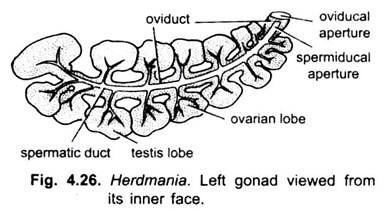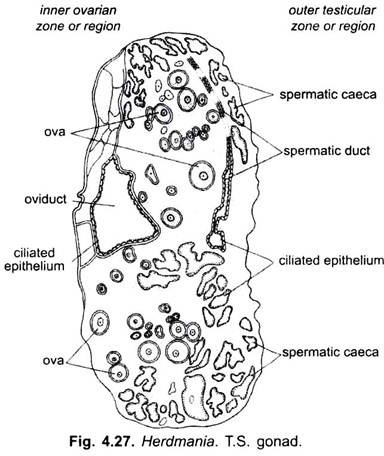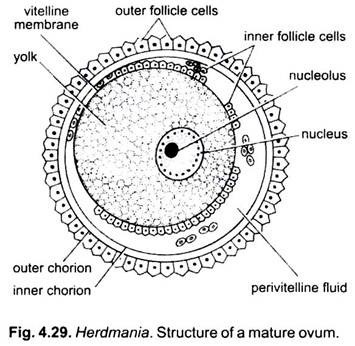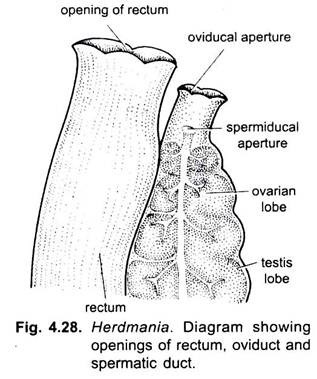The animal is hermaphrodite or bisexual and protogynous, i.e., ovary matures first, thus, self-fertilisation is avoided.
Gonads:
There are two large gonads embedded in the mantle, the left one lies in the loop of the intestine and the right one dorsal to the heart. Each gonad is about 3 × 1 cm, and consists of 10 to 25 lobes lying in two rows. The posterior unpaired lobe being the largest. Each lobe has an outer, reddish testicular part which produces sperms, and an inner, pinkish ovarian part having ovum. Thus, each lobe of gonad is hermaphrodite.
Gonoducts:
The ovarian parts of each gonad are joined by narrow ovarian ductules to a thick oviduct, while the testicular parts are connected to a thin spermatic duct or vas deferens by spermatic ductules. The oviduct and vas deferens run parallel and open by their own apertures (oviducal and spermiducal apertures respectively) into the atrial cavity where ova and sperms are discharged.
ADVERTISEMENTS:
Oviducal aperture lies a little behind the anus and spermiducal aperture are little behind the oviducal aperture. Both the gonoducts are ciliated internally. The sex cells pass out of the atrial siphon into the sea. Generally cross fertilisation occurs in sea water.
It is suggested that the neural gland secretes a hormone similar to the one produced by the anterior lobe of the pituitary of vertebrates. The hormone influences the brain which stimulates the gonads to release their gametes. In this way the animals fixed close to each other are stimulated to spawn at the same time, thus, ensuring cross fertilisation.
Gametes:
A mature spermatozoan is about 4 mm in length. Each sperm has ovoid head bearing a long beak-shaped acrosome, a middle piece and a long tail.
ADVERTISEMENTS:
Sperms are of three types:
(i) Beak and head are of equal length,
(ii) Beak three times longer than the neck, and
(iii) Beak is three times shorter than the neck.
ADVERTISEMENTS:
A mature ovum (Fig. 4.29) is about 0.3 mm in diameter. Its cytoplasm contains well distributed yellowish granulated yolk. Nucleus is eccentric with a conspicuous eccentric nucleolus. The ovum is surrounded by a thin vitelline membrane, which is further enveloped by two chorion membranes secreted by the follicular cells of the ovary. In between the vitelline membrane and inner chorion is a perivitelline space filled with perivitelline fluid.
A number of follicle cells are found attached with the vitelline membrane and a few are found floating in the fluid. In between the outer and inner chorion membranes is found in the inter-chorional fluid. Follicle cells are also remain attached with the outer surface of the outer chorion. These cells keep the ovum floating in water.
Fertilisation:
Fertilisation is external. Since the animal is protogynous, i.e., ova matures earlier than the sperms, only cross fertilisation occurs.



